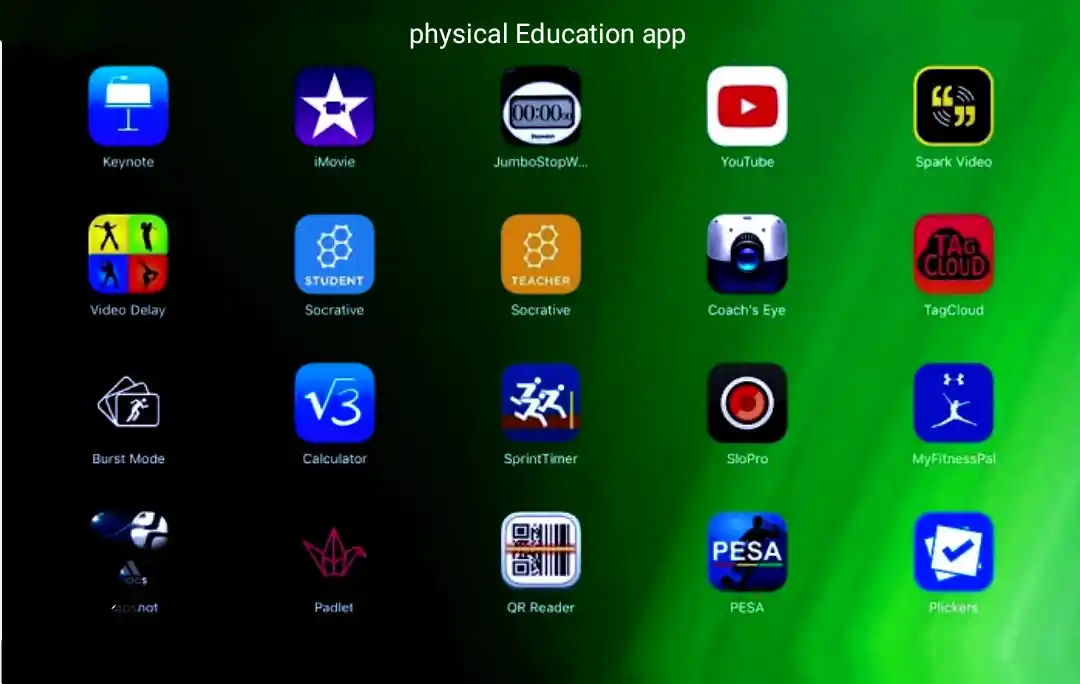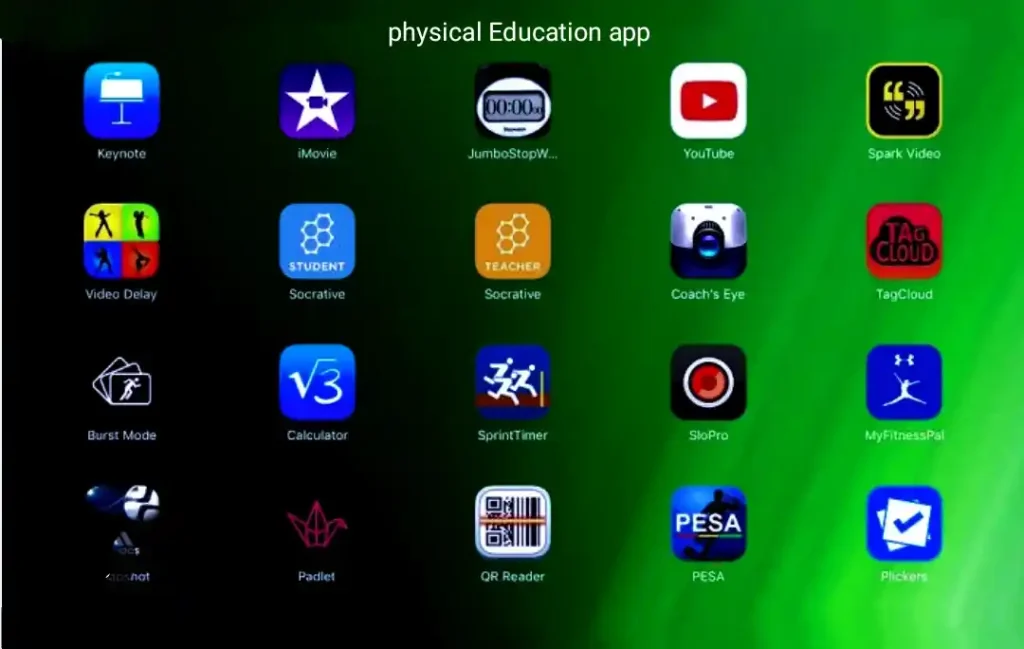Physical Education Apps: Revolutionizing Fitness Education in the Digital Era

Introduction
Technology has revolutionized many aspects of our daily lives, and physical education is no exception. Today, digital tools have made fitness more accessible, convenient, and enjoyable for people of all ages. In particular, physical education apps have reshaped how we engage with exercise, track progress, and maintain healthy habits. From school-aged children to adults looking for a more structured exercise routine, these apps have made physical activity more engaging and personalized than ever. In this blog post, we’ll explore how physical education apps are changing the landscape of fitness education, discuss their various features and benefits, and delve into some of the top apps available today.
1. The Role of Technology in Physical Education
Table of Contents
Technology adoption in physical education has grown significantly over the past decade, and the reasons are clear. Physical education (PE) apps make exercise accessible to people regardless of location, equipment, or fitness level. They remove many traditional barriers to fitness, such as lack of time, intimidation at gyms, or lack of guidance.
Technology is helping bridge the gap between formal physical education classes in schools and a culture of lifelong fitness. For students, PE apps can offer guided exercises, reminders, and motivational content that extends beyond the classroom. Meanwhile, these tools can provide personalized coaching and continuous tracking of physical activity levels for adults and seniors. In both cases, mobile technology enhances learning and fosters a commitment to health and well-being.
2. Benefits of Physical Education Apps
2.1 Accessibility and Convenience
One of the most significant advantages of physical education apps is their accessibility. Users can exercise whenever and wherever they like, whether at home, in a park, or even at the office during a break. Fitness routines can be modified to fit into busy schedules, making it easier for people to prioritize their health without needing specialized equipment or costly gym memberships.
These apps also help remove the intimidation some people feel when starting a new exercise routine. By allowing users to exercise at their own pace and in the privacy of their homes, physical education apps can encourage people to take that first step towards better health.
2.2 Personalization and Adaptability
One of the standout features of PE apps is their ability to provide personalized experiences for each user. Using data such as age, gender, height, weight, and fitness goals, these apps can generate tailored workouts and track progress over time. Personalization is critical to ensuring users stay motivated and sustain their fitness journey.
Whether users want to lose weight, improve strength, increase flexibility, or simply stay active, physical education apps can adapt to suit their individual goals and preferences. Many apps use artificial intelligence to adjust exercise routines based on user feedback, ensuring that workouts remain challenging but achievable.
2.3 Variety of Workouts
Physical education apps offer various workouts to cater to different preferences and fitness levels. There is something for everyone, from yoga, Pilates, and strength training to high-intensity interval training (HIIT), cardio, and even dance-based workouts. The variety ensures users stay energized, making developing a consistent exercise routine easier.
Moreover, many apps include guided workouts led by professional trainers, giving users the feeling of working with a personal coach without the associated costs. Videos, voice cues, and instructions provide valuable guidance, helping users perform exercises correctly and avoid injuries.
2.4 Progress Tracking and Metrics
Tracking progress is crucial for staying motivated in any fitness journey, and physical education apps excel in this area. Users can visualize their progress over time by monitoring metrics such as calories burned, steps taken, heart rate, and workout frequency. Seeing tangible improvements in fitness levels can be a powerful motivator.
Most apps provide analytics and progress reports, which help users understand their strengths and areas of improvement. Many also sync with wearable fitness devices like smartwatches, providing a more comprehensive overview of physical activity.
2.5 Gamification and Motivation
Gamification is a popular feature in many physical education apps that helps keep users engaged. By incorporating challenges, leaderboards, rewards, and badges, these apps tap into users’ competitive instincts and make exercising fun. Some apps offer social features, allowing users to challenge friends or join online communities for extra motivation.
Gamification elements make workouts more enjoyable and help build a sense of accomplishment, encouraging users to stick to their routines.

3. Top Physical Education Apps in 2025
- Nike Training Club
Nike Training Club is one of the most popular fitness apps available today, and for good reason. It offers a wide range of workouts designed by professional trainers, including strength training, endurance, yoga, and mobility exercises. The app also provides personalized workout recommendations based on user preferences and fitness levels, making it suitable for beginners and experienced athletes.
- MyFitnessPal
Although primarily known as a nutrition tracker, MyFitnessPal also has physical activity tracking features. It helps users log exercises, track calories burned, and set fitness goals. The app integrates well with other fitness tools and wearables, providing a holistic approach to health and wellness by combining physical activity, nutrition, and goal-setting.
- FitOn
FitOn offers a variety of workouts, including dance, HIIT, strength training, and meditation, all led by celebrity trainers. One of the standout features of FitOn is that it provides free, high-quality workout videos, making it accessible to a broad audience. The app also offers social features, allowing users to work out with friends virtually.
- Sworkit
Sworkit (Work It) focuses on providing custom workouts that can be done anywhere, with or without equipment. The app offers flexibility for users with limited time, allowing them to set the duration of their workouts. Sworkit is particularly useful for beginners, as it provides instructional videos and helps users gradually build their fitness level.
- 7-Minute Workout
The 7 Minute Workout app is ideal for those who struggle to find time for exercise. It provides short, high-intensity workouts that target all major muscle groups and can be done without any equipment. Despite their brevity, these effective workouts help users build strength and improve cardiovascular fitness.
4. Physical Education Apps for Schools and Students
Schools are increasingly adopting physical education apps to enhance their PE curriculum. These apps can provide interactive workouts, track students’ progress, and promote physical activity beyond school hours. Some of the most popular PE apps for students include:
- GoNoodle
GoNoodle is an app designed specifically for children that combines exercise with educational content. It offers fun, interactive videos that encourage movement and help children stay active while learning. GoNoodle is widely used in schools to get kids moving between lessons and promote physical activity in a fun and engaging way.
- ClassFit
CrossFit is designed to help PE teachers manage their classes more effectively. The app allows teachers to create customized workout plans, track students’ progress, and provide feedback. It also offers a variety of exercise videos that can be used in class, making it easier for teachers to keep students engaged and active.
- PE Buddy
PE Buddy is a versatile app for physical education teachers that includes lesson plans, assessment tools, and a library of exercise videos. The app helps teachers create structured PE lessons, track students’ performance, and ensure students meet their physical activity goals.
5. Physical Education Apps for Special Populations
Physical education apps are not just for the general population; many are specifically designed for special populations, including seniors, individuals with disabilities, and those recovering from injuries.
- SilverSneakers GO
SilverSneakers GO is an app designed for older adults. It offers workouts that focus on balance, strength, flexibility, and mobility. The app provides easy-to-follow videos and allows users to choose workouts that match their fitness level. It also includes tracking features to help seniors monitor their activity levels and stay motivated.
- Special Olympics Fit 5
The Special Olympics Fit 5 app is designed to help individuals with intellectual disabilities maintain a healthy lifestyle. The app encourages users to engage in physical activity five times per week, eat five servings of fruits and vegetables daily, and drink five glasses of water daily. It provides simple, accessible exercises and helps users track their progress toward these goals.
6. Overcoming Challenges in Physical Education with Apps
Despite the numerous benefits of physical education apps, challenges still need to be addressed. Some of the main challenges include:
- Screen Time Concerns
One concern about using physical education apps, especially for children, is the potential increase in screen time. Parents and educators must ensure that screen time is balanced with other physical activities and outdoor play.
- Digital Literacy and Accessibility
Only some have access to smartphones, tablets, or reliable internet, which can be a barrier to using physical education apps. Additionally, some individuals may need help with digital literacy, making it challenging for them to navigate these apps effectively. Addressing these issues requires collaboration between app developers, educators, and policymakers to ensure that fitness tools are accessible to everyone.
- Motivation and Accountability
While many apps use gamification and social features to boost motivation, some users may need help to stay consistent. Accountability is crucial for maintaining a fitness routine, and with a personal trainer or teacher present, some individuals may find it easier to stay on track. Community support and integrating apps with other fitness resources can help address this issue.
7. Future Trends in Physical Education Apps
The future of physical education apps looks promising, with many exciting developments on the horizon. Some trends to watch for include:
- Integration with Virtual Reality (VR)
Virtual reality is poised to take physical education to the next level by creating immersive exercise experiences. VR-based fitness apps can transport users to different environments, such as running through a forest or climbing a mountain, making workouts more engaging and enjoyable.
- Artificial Intelligence and Adaptive Training
Artificial intelligence (AI) is playing a more significant role in fitness apps. Many platforms use AI to create adaptive workouts that adjust based on user progress and feedback. AI can help personalize fitness routines further, ensuring that workouts are always challenging yet achievable.
- Wearable Technology Integration
Wearable technology, such as smartwatches and fitness trackers, is increasingly integrated with physical education apps. This trend allows users to collect more data about their physical activity, including heart rate, sleep patterns, and calorie expenditure, providing a more comprehensive view of their overall health.
Conclusion
Physical education apps have transformed how we approach fitness, making it more accessible, personalized, and enjoyable. These tools have the potential to foster a culture of lifelong fitness, helping people of all ages and abilities stay active and healthy. We can expect even more innovative features and tools to enhance our physical education experience as technology advances.
Whether you’re a student, an adult looking to stay fit, or an educator trying to engage your students in physical activity, there’s a physical education app out there to meet your needs. The key is to find the best app for you and use it as part of a balanced and consistent approach to health and wellness.
With the right tools and mindset, everyone can take control of their physical well-being and embark on a healthier lifestyle.
>> The journal of criminal justice education



